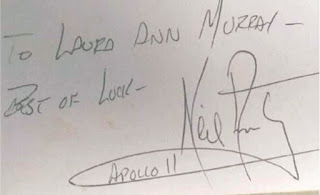Preemptive Rulings Sought in Moon Dust and Bronze Horse Cases
 |
| Note reportedly written by Neil Armstrong. Source: court papers filed in Cicco v. NASA |
“To Laura Ann Murray – Best of Luck – Neil Armstrong Apollo 11.” This message accompanied a vial of moon dust that Laura Cicco (neé Murray) received from her mother when she was about ten years old. The first man to set foot on the moon scribbled the note on the back of a business card carried by Cicco’s father, who was friends with Armstrong.
These are some of the claims Cicco makes in a declaratory judgment (DJ) pleading her lawyer filed in Kansas federal court on June 6.
Cicco’s suit against the National Aeronautics and Space Administration seeks a declaration that she is the bona fide owner of the moon dust. The case of Cicco v. NASA (2018-cv-01164) invokes the Declaratory Judgment Act 28 U.S.C. § 2201, which allows a party to petition a federal court for a binding ruling that resolves the petitioner’s rights in a case that is ripe with controversy.
Meanwhile, in the Southern District of New York, both the Barnet family and Sotheby’s auction house filed a DJ action on June 5 in response to legal threats made by the Greek government to seize a Greek horse sculpture dating to the 8th century BC. The plaintiffs want the federal district court to declare the family the lawful owner of the ancient bronze statue.
 |
| The vial of moon dust in dispute in Cicco v. NASA. Source: court papers filed in Cicco v. NASA |
In the moon dust suit, Cicco’s lawyer writes in the court complaint that NASA “has taken the position that all lunalogic material is the property of NASA,” pointing to the recent Central District of California case of Joann Davis v. United States (2013-cv-0483).
The Davis case concerned the ownership of a speck of moon rock placed in a paperweight. Neil Armstrong purportedly gave the paperweight to Joann Davis’ husband, a former manager of North American Rockwell’s Apollo program, and Joann Davis inherited the paperweight upon her spouse’s death. But NASA took possession of the moon rock speck when its investigators conducted an undercover operation that seized the paperweight during a sting that lured the 73 year old widow to a Denny’s restaurant. The court awarded the lunar material to the space agency.
Notwithstanding the result in Davis, Cicco’s lawsuit asserts, “There is no law against private persons owning lunar material. Lunar material is not contraband. It is not illegal to own or possess.” NASA likely will counter, as it did in the Davis case, that the National Aeronautics and SpaceAct of 1958 and NASA Policy Directive 1387 vest ownership of moon rocks and dust to the U.S. government.
 |
| Greek bronze horse in the Barnet collection. Source: Sotheby’s |
Like the moon dust suit, the DJ action in New York seeks to stave off the seizure of an artifact. Greece’s Ministry of Culture and Sports requested that the Barnet family turn over the ancient bronze horse or face legal consequences, including criminal penalties. (Although unmentioned, other legal consequences might have included a replevin suit launched by Greece to recover the cultural property or, more probably, a seizure and forfeiture of the archaeological object by U.S. authorities at the Greek government’s request.)
Petitioners filed the case of 2012 Saretta Barnet Revocable Trust and Sotheby’s v. Ministry of Culture and Sports of the Hellenic Republic (18-cv-4963) to preclude action by the Greek government. The DJ suit alleges that Howard and Saretta Barnet displayed the Greek horse in their Sands Point, NY home for over two decades after the couple bought it from antiquities dealer Robin Symes in November 1973 for approximately £15,000. Before then, the statue had been auctioned in 1967 at Münzen und Medaillen in Basel, Switzerland, according to the court complaint, and Jean-Louis Zimmerman of the University of Geneva later featured the Barnet’s statue in the 1989 book, Les Chevaux de Bronze dans L’art Geometrique Grec.
The complaint adds that Saretta Barnet maintained sole ownership of the bronze after her husband’s death in 1992. She displayed the piece in her Park Avenue apartment from 1997 until the time she passed away in March 2017. During this period, the Saretta Barnet Revocable Trust (Howard J. Barnet, Peter L. Barnet and Jane L. Barnet trustees) acquired title in 2012 to the ancient horse. The family thereafter consigned the horse to Sotheby’s in July 2017 for auction on May 14, 2018 at “The Shape of Beauty: Sculpture from the Collection of Howard and Saretta Barnet” (Lot 4), which displayed an estimated price tag of between $150,000 and $250,000.
“The Bronze Horse was acquired lawfully and in good faith by the late Howard and Saretta Barnet 45 years ago and has been part of their collection ever since,” the plaintiffs’ attorneys write. They protest that “one business day before Bronze Horse was to be auctioned, Sotheby’s received a letter by e-mail, from the Ministry of Culture … marked ‘URGENT,’” and “asserted that the Bronze Horse is cultural property that had been stolen from Greece in violation of Greek patrimony laws, asserted Greece’s ownership of the Bronze Horse, and threatened that persons in the United States involved in the sale of the Bronze Horse would be subject to criminal prosecution in Greece.”
The plaintiffs say that Greece gave no evidence the statue had been stolen but, as a conseuquence, “Greece’s claim to ownership of the Bronze Horse, however meritless, has impaired Sotheby’s ability to sell it on behalf of the Barnet Family.” So plaintiffs withdrew the horse from the auction and petitioned the federal district court to declare the Barnet family the true owner of the artifact and to rule that there is “no basis for the forfeiture or repatriation of the Bronze Horse under U.S. or international law” so that Sotheby’s can sell the artifact.
While the plaintiffs’ DJ complaint acknowledges that antiquities dealer “Symes was accused of trading in looted antiquities,” that was “[d]ecades later,” well after the Barnet’s purchased the bronze horse, adding that “the documented provenance of the Bronze Horse pre-dates Symes’ alleged acquisition of the object. Therefore, Symes’ involvement with the Bronze Horse lends no support to Greece’s claim of ownership to the Bronze Horse,” the petitioners insist.
The DJ action filed by the Barnet family and Sotheby’s is uncommon and likely will compel Greece to hire private counsel in the U.S. to defend its claim to the bronze horse. This scenario differs from the usual pattern where an alarm is raised over suspected stolen antiquities offered for sale, prompting intervention from American prosecutors and police who seize the artifact, sue to forfeit title, and then send the cultural object to the county of origin–the seize and send strategy. Think of the case of United States of America v. A 10th Century Cambodian Sandstone Sculpture Currently Located at Sotheby’s, for example, with which Sotheby’s in New York has direct experience.
The Cicco matter, like the bronze horse case, also is preemptive and uncommon. That DJ action almost certainly will forestall any effort by authorities to conduct an undercover police sting like the one undertaken in the Davis case.
Text and original photos copyrighted 2010-2018 by Cultural Heritage Lawyer, a blog commenting on matters of cultural property law, art law, cultural heritage policy, antiquities trafficking, museum risk management, and archaeology. Blog url: culturalheritagelawyer.blogspot.com. Any unauthorized reproduction or retransmission without the express written consent of CHL is strictly prohibited. The materials presented on this site are intended for informational purposes only and should not be used as legal advice applicable to the reader’s specific situation. In addition, the provision of this information to the reader in no way constitutes an attorney-client relationship.

